Thanks for removing the paywall. Nice to have something more substantive to respond to. I'll start w the briefer points then the multi-part ones.🧵
https://twitter.com/PLeithart/status/1954879722669707473
re the burnt offering see LotF, 30n11 & pg 90. (I also suggest reading Jonathan Klawans’ books on sacrifice.) Regardless, even if we say the burnt offering always atones, it’s still not atoning *people*, but rather the altar. (I’ll return to this point since PL contests this.)
Re the death of the sacrificial animal see LotF, 20–21. Readers can decide between Leithart (pic 1) and myself/Shauf/Moffitt/Eberhart (pics 2 & 3). 


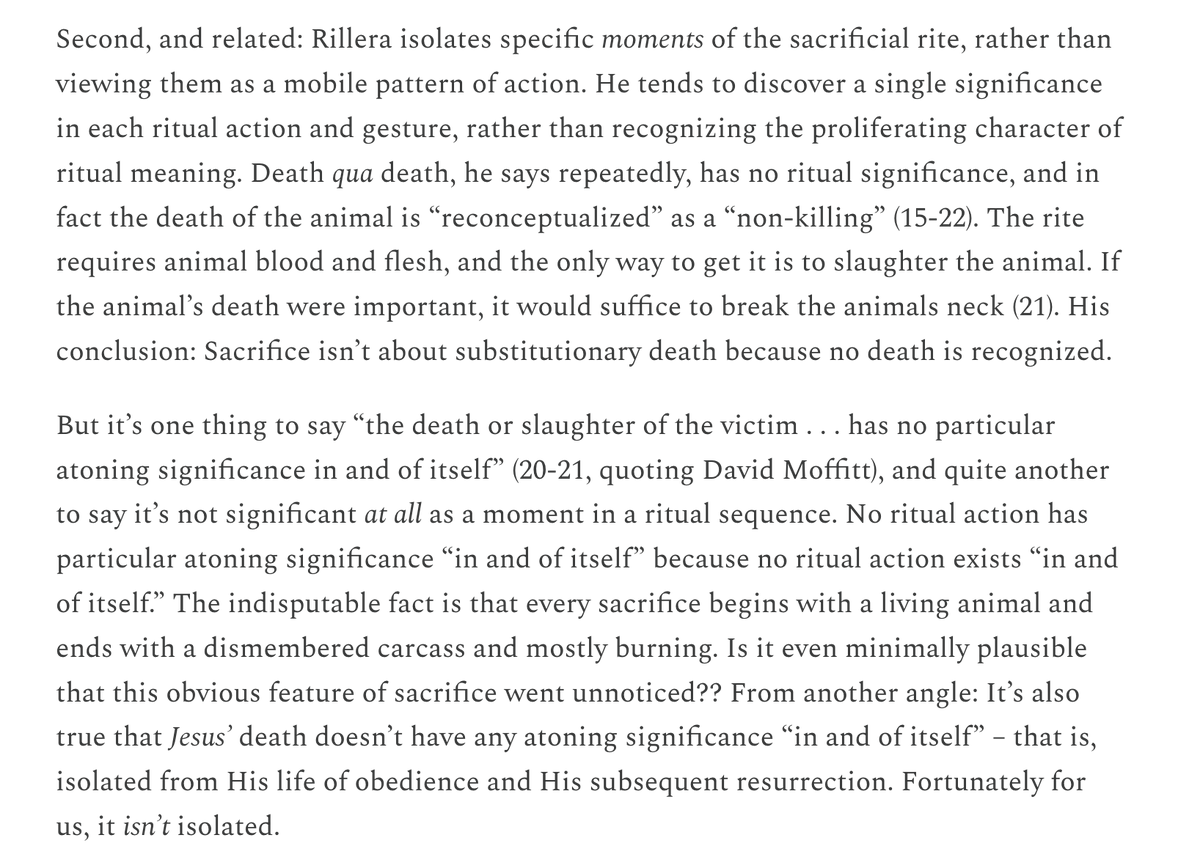


Re passover. What I actually wrote was that "the *first* Passover is not a sacrifice” (p 41), but that the subsequent ones are “sacrifices.” I lay this out on the next pages (p 42–44). 

"However, the author notes that each subsequent Passover will be celebrated as a 'sacrifice' (zebaḥ, Exod 12:27) when it is incorporated into the sacrificial and calendrical framework." (LotF, 42). I then discuss the sig of Passover being a *sacrifice* in Deut 16 & Num 9.
Why isn’t the *first* passover a sacrifice? No altar, no priest, and they ate it roasted (sacrificial meat that is eaten is always boiled).
Re passover and substitutionary death. See LotF, 44–54 (not screenshotting all of that!). Leithart merely asserts in a parenthesis "(His argument that Passover wasn’t a substitutionary death is very strained, pp. 44-54).” Decide for yourselves I guess.
Would be nice to know what probs he has with my discussion of God’s right to the firstborn males & how it coordinates w the Levites.
Re Num 15:25 and ʾiššeh. I’m glad I get to correct this finally. It’s been bugging me ever since I realized I never corrected this in the proofs. I found Num 15:25 when I was fact checking Schwartz, whom I quote on pg 34n28. 
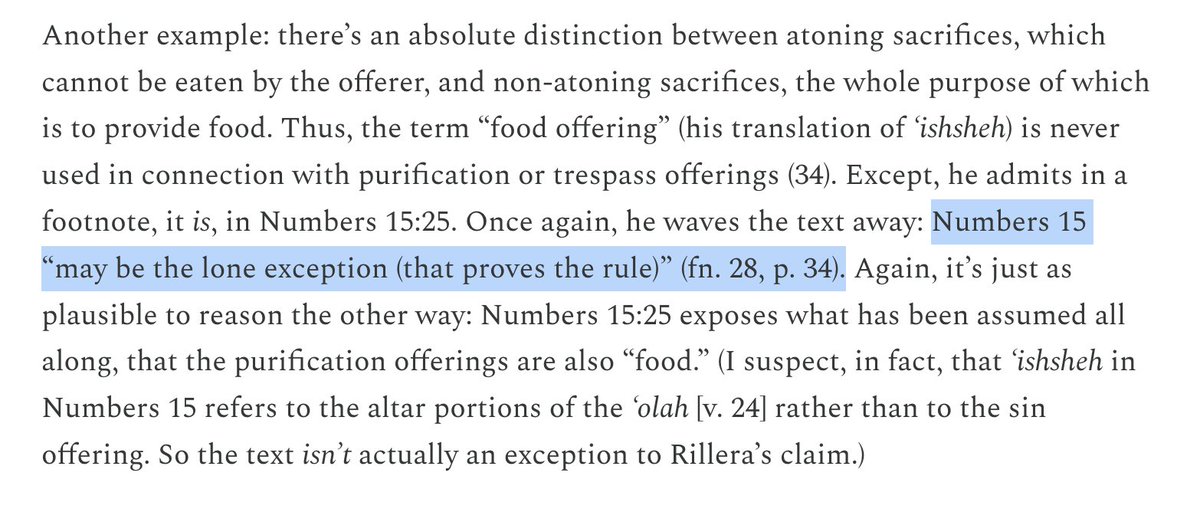
My weird system was to have "???” in places I wanted to revisit/edit/revise. This is the copy in my notes of what I meant to revise it to, but I obviously deleted the ??? & didn’t realize I never actually pasted that in (ADHD is usually helpful for my writing but not here!):
Numbers 15:25 may seem like an exception, but is not: “because the purification offering is not an ʾiššeh, it had to be listed separately” (Milgrom, Leviticus 1–16, 268; cf. 161, 253, 433).
It’s a very minor point, but it obviously irritates more than just myself.
It’s a very minor point, but it obviously irritates more than just myself.
Re Baden: Leithart leaves out Baden's last sentence from what he quotes. Also, note how Baden says its “that they fast & abstain from working (16:29)” that effects “this new purging” (ie, the hatta’t sacrifices r *not* what purge the people). This is what I explain on pp 138–39. 



I'm not sure if Baden would agree w me, but I build on his observation re Lev 16:29 on fasting and not working that Leithart didn't think was relevant (see LotF, 139n132; 4th pic in previous tweet).
Leithart just says that Baden & I differ but he doesn't respond to or rebut my own observations/args on these pages.
Also relevant: later I show how Rabbi Aqiva’s interp Lev 16:30 cooroborates the way I’m connecting the dots on pp 138–140 (cf. 215–18 re 1 John 1:7 & Lev 16:30).


Also relevant: later I show how Rabbi Aqiva’s interp Lev 16:30 cooroborates the way I’m connecting the dots on pp 138–140 (cf. 215–18 re 1 John 1:7 & Lev 16:30).
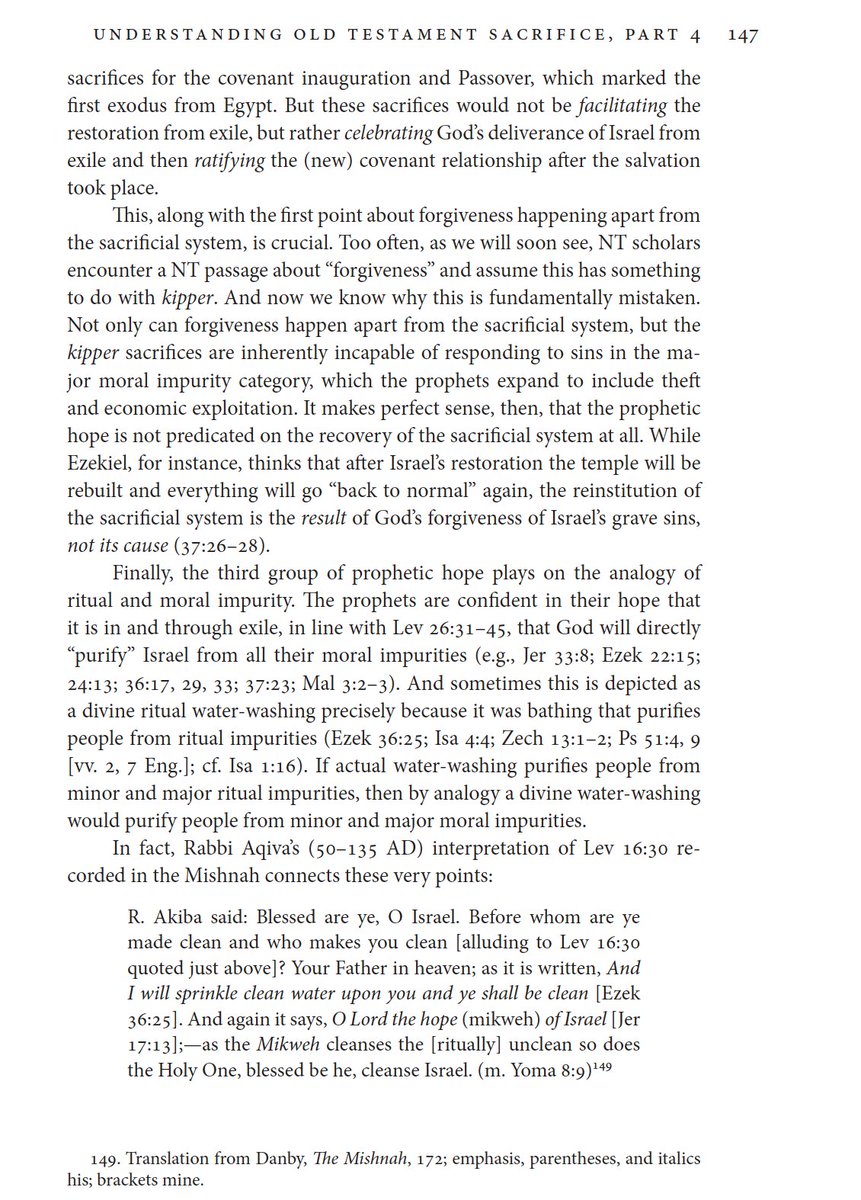
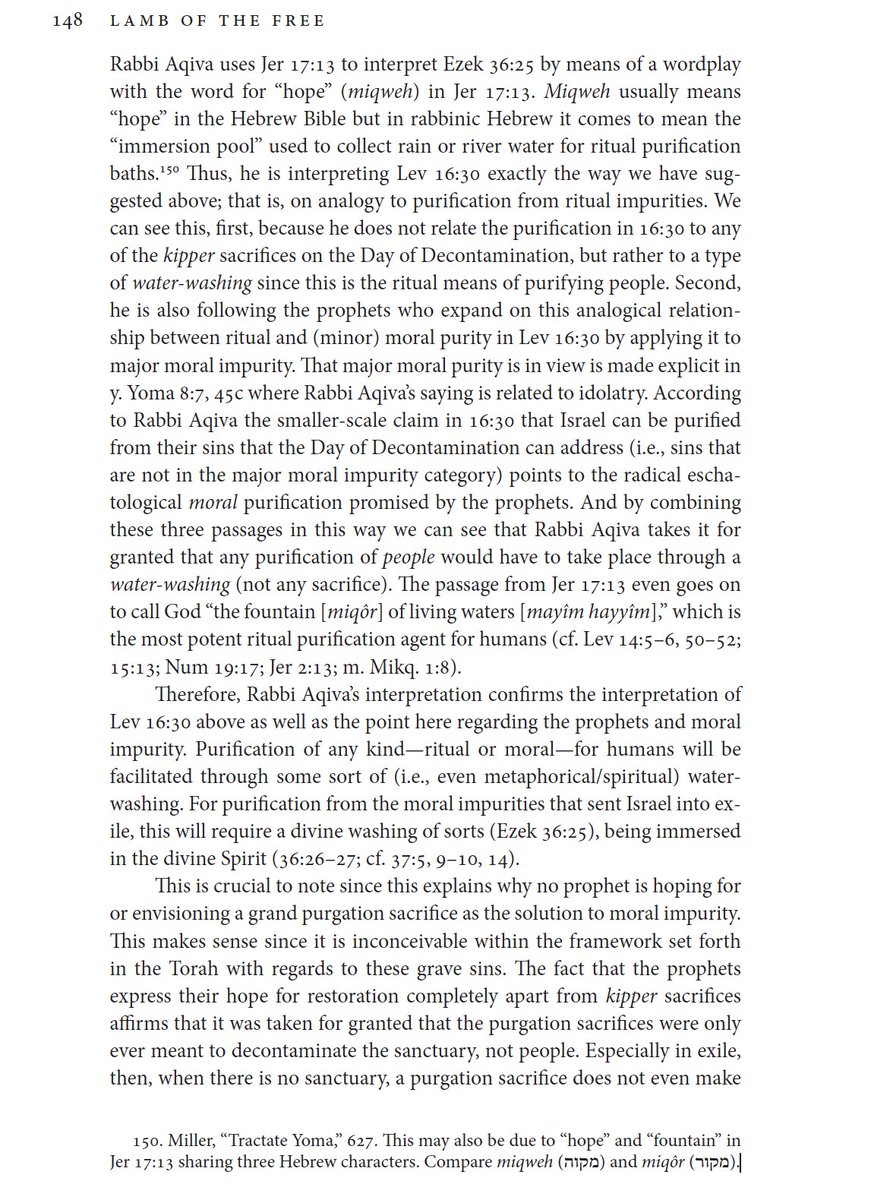

Re tabernacle=the people. The NT def identifies individuals & the church as the temple, but I’m not persuaded by the *extrapolations* of this line of reasoning. Isn’t it curious how both the prophets & the NT authors apply *water-washing* rituals to *humans* rather than kipper? 

Eg, while Paul says that our bodies are temples (1 Cor 6:19), notice that as *human bodies* he says we are cleansed through water “washing” and the Divine Spirit (6:11) (just like Ezek 36 said & the Levitical protocols for human purification set forth as I detail in LotF).
Also, Heb 9:13–14 & 10:22 analogizes Jesus’s blood to water and the special ash-water for corpse impurity from Num 19. And “dead” & “Spirit” in Heb 9:14 evoke the promised washing/resurrection from Ezek. Ezek 36–37). For details LotF, 145–49, 159, 206, 215–18, 231n41, 253–71.
Related re priests as sancta. As I discuss on pp 58–66, we already know what kind of sacrificial blood goes on people & it is never blood from an atoning purgation (hatta't) sacrifice. 

And this is especially important for the blood that goes on priests because they get turned into living / "walking sacred-dwelling-place furniture” (LotF, 60 & cf n113). But this ordination blood comes from the non-atoning ordination sacrifice (a type of well-being sacrifice).
Imortantly, whenever *atoning purgation sacrifice blood* gets on priests they need to bathe (since water [and time] is what purifies people/bodies) (see p97). 

So if the original people who became human-sanctuary-furniture were never "atoned," then (to my mind) we are lacking sufficient warrant for the extrapolation Leithart desires.
Since we know the blood rituals that were performed on people, even on people who become part of the sancta, so we should analogize from those. And I think this is exactly what NT authors do as I detail when I get to the NT (LotF, 179–80, 200–201, 216–18, 227, 227n31, 228n32).
Again, my aim is to understand how NT make use of Levitical imagery, and none of them say that *humans* are the objects of atonement.
That's it for his review, but I want to go back to 1 Cor 6 for sec though to tease something out relevant to the tabernacle=people stuff.
It seems Paul was dealing w some in Corinth over-interpreting the whole "we are the temple/sanctuary of the Holy Spirit” (just like Leithart).
But the direction the Corinthians take is to adopt abstinence in marriage (1 Cor 7:1) most likely bc sex is a source of ritual impurity (Lev 15) (& ritual impurity = can't access sacred space or sacred food; e.g., can't touch or eat from a well-being sacrifice or handle tithes).
A strict temple=people logic would mean sex is permanently banned for Christians bc it would necessarily profane our temple-bodies. This is the logic Paul was opposing in 1 Cor 7 (surprisingly, Paul actually says sex *sanctifies* the unbelieving spouse & their kids in v 14!)
Therefore, being “temples” ought not be pressed too far according to Paul. Problems about when metaphors and analogies are pressed to far. Who would have thought?
So I wonder if Leithart agrees with Corinthian extrapolation and applies temple logic to his entire bodily existence. If not, I wonder what his methodological controls are for deciding what is or isn’t viable extrapolations of the people=temple theology.
If the controls are what is or isn’t affirmed in the NT, then that’s all I’m doing in LotF. No NT authors goes from temple=people to “people are the objects of kipper.” I’m just reporting and documenting that fact. End.
@threadreaderapp unroll please
• • •
Missing some Tweet in this thread? You can try to
force a refresh











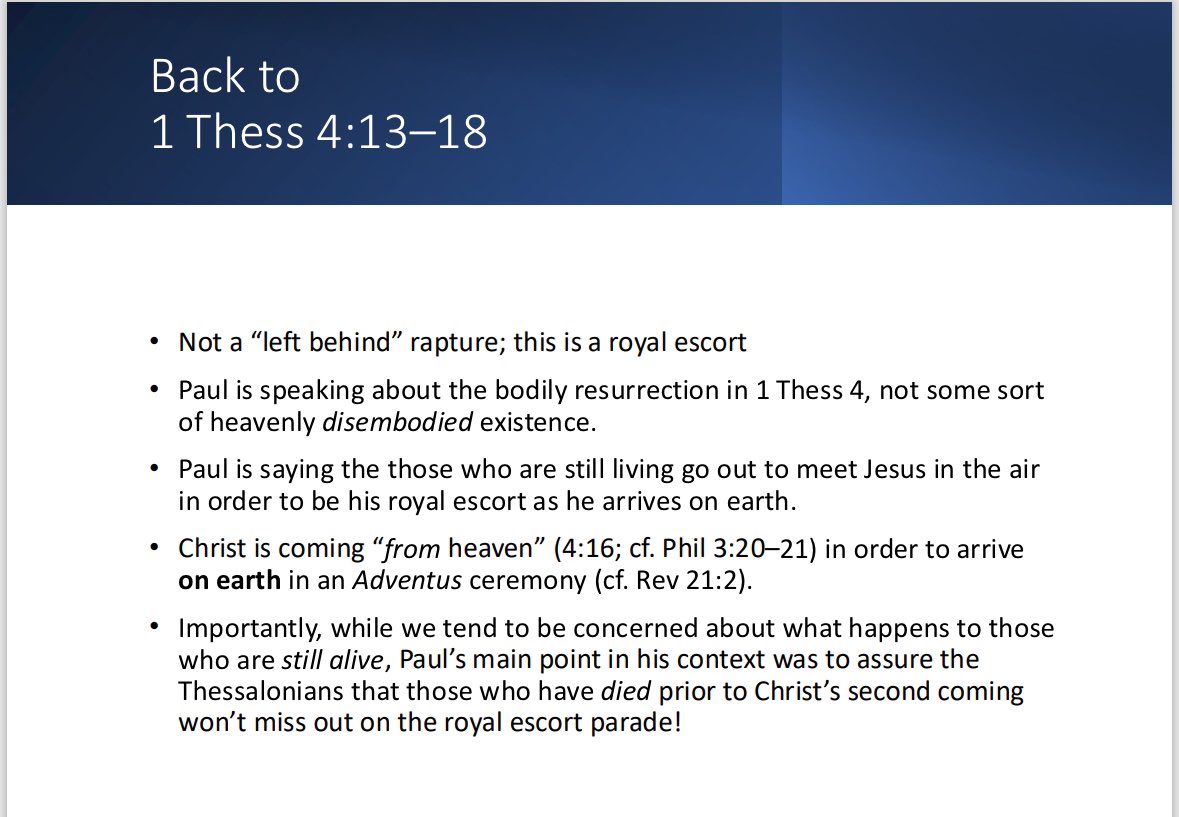
![It's a U-Turn! • This whole section of 1 Thess 4 only makes sense on the assumption that everyone was expecting to participate in the royal escort parade of Jesus back down to earth. • The Thessalonians were sad their dead loved ones would miss out! • Paul says those who are still alive at "the coming of the Lord will by no means precede those who have died...the dead in Christ will rise first... after that we who are alive, who are left, will be caught up in the clouds together with them to meet the Lord in air [on his way down to rule the earth]" (4:15-17). • Essentially, the &q...](https://pbs.twimg.com/media/G1Y9PwQWoAEYzQf.jpg)
!["one will be taken and the other left" (Luke 17:35-36, parallel in Matt 24:40-41) • Luke 17:35-36 (parallel in Matt 24:40-41) "one will be taken and the other left." • Context in Luke 17:26-37 and Matt 24:28-41: • The one "taken" is taken to judgment. • It is likened to the flood that "took them all away" (Matt 24:39) or "destroyed them" (Luke 17:27, also likened to Sodom in v. 29). • The disciples in Luke ask "where [are they taken], Lord?" (17:37). • Jesus's response is clear that they are taken by the Roman legions (prophesying ...](https://pbs.twimg.com/media/G1Y9Rd3WUAAMqJw.jpg)






